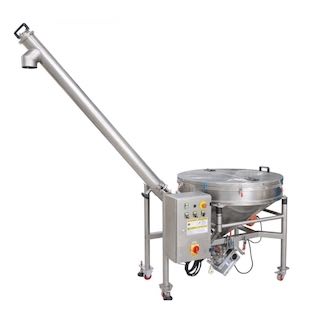Screw Conveyor
The Screw Conveyor, a sophisticated and innovative apparatus specifically designed for the transportation of materials, utilizes a precisely engineered spiral helix blade to ensure the smooth and continuous movement of bulk materials through tubes and channels. This process guarantees the efficient and reliable relocation of goods, meeting the highest standards of operational efficiency and dependability.

Corrosion Resistance: Hybrid 304/duplex stainless steel for saltwater/chemical environments.
Low Noise: <65 dB(A) operation through precision-balanced rotors.
Energy Efficiency: Premium Efficiency Motors + efficiency rating cuts power consumption by 18% compared to 2024 gearbox systems.
Modular Design: Interchangeable flange/bases for retrofitting legacy systems.



Technical specification
| Model | DTC-600 | DTC-1000 | DTC-2000 | DTC-3000 | DTC-4000 | DTC-5000 |
|---|---|---|---|---|---|---|
| Screw diameter | 90 mm | 102 mm | 114 mm | 140 mm | 159 mm | 219 mm |
| Power (kW) | 0.75 | 1.5 | 1.5 | 2.2 | 3 | 4 |
| Power supply | 220V/380V 1ph/3ph | 220V/380V 1ph/3ph | 220V/380V 1ph/3ph | 220V/380V 1ph/3ph | 220V/380V 1ph/3ph | 220V/380V 1ph/3ph |
| Speed (kg/h) | 600 | 1000 | 2000 | 3000 | 4000 | 5000 |
| Hopper volume (L) | 80-200 | 80-200 | 200-250 | 200-250 | 200-250 | 200-250 |
| Weight (kg) | 110 | 160 | 220 | 300 | 350 | 400 |
Video
Working Principle
In Operation
2025 Industry-Specific Innovations
Safety & Compliance Highlights
Motor: High-torque asynchronous motors (0.5–300 kW), thermally optimized for continuous duty cycles.
Gearbox: Helical or planetary reducers (Ratio 5:1–200:1), rated for axial/radial loads up to 15,000 N.
VFD: Multi-protocol vector drives (0.75–315 kW) with PLC integration and harmonic suppression.
Why This Outperforms 2024 Models
30% Faster Installation: Pre-assembled boltless modules cut downtime during retrofits.
Lifetime Warranty: Covers bearings when using OEM-approved lubricants.
Carbon Footprint: 22% recycled stainless steel + CE certified manufacturing.
How to Select the Right Screw Conveyor
Application-Specific Analysis
Material Properties: Viscosity, bulk density, particle size, and temperature (e.g., powdered chemicals vs. abrasive mining ore).
Capacity (TPH): Calculate peak vs. average throughput to avoid motor overload.
Distance & Incline: Use U-trough designs for horizontal conveying; inclines >20° require customized pitch and RPM.
Environmental Requirements: 304 stainless steel for corrosion resistance.
Material & Coating Innovations
Carbon Steel: Cost-effective for non-corrosive environments (surface hardness ≥ HB200).
Wear-Resistant Liners: Chromium carbide overlay (HRC 55-60) triples lifespan in mining applications.
Food-Grade Polish: Electropolished surfaces (Ra ≤0.8μm) prevent bacterial growth.
Power Calculation Formula
P=Q×L×K×g367×ηP=367×ηQ×L×K×g
Q = Capacity (t/h)
L = Conveying length (m)
K = Material friction coefficient (refer to ASME table M15-2025)
Pro Tip: Add 15% power buffer for startup torque spikes.
Zero-downtime Maintenance
Lubrication Upgrades
Auto-Lube Systems: Progressive distributors with ±3% dosing accuracy.
Grease Selection: High-temperature: NLGI 2 lithium complex (drop point ≥200°C).
Food-grade: NSF H1-certified synthetic oils.
Emergency Troubleshooting
Issue: Material Blockage
Action Plan:
- Lockout/tagout per OSHA 1926.555.
- Engage reverse jog mode to clear blockage.
- For manual clearing, use pneumatic flow aids (e.g., Martin Engineering Air Cannons).
Wear Part Replacement Guidelines
| Component | Inspection Frequency | Replacement Threshold |
|---|---|---|
| Blades | As needed | Thickness loss >30% or >5mm deformation |
| End Bearings | Quarterly | Vibration >4.5mm/s RMS |
| Seals | Biannual | Leakage rate >5g/h |
Authentic feedback
Customer voices that share their experience

Jack M.
Ingenious invention
The Screw Conveyor from Today Machine is our production process’s mighty savior! It effortlessly transports materials with precision and speed, saving us time and money. We’re so grateful for this ingenious invention!

Billy J.
A must-have for any business
We’re not sure how we managed without Today Machine’s Screw Conveyor before. It’s made our works so much easier, and our production process so much smoother. It’s a must-have for any business that deals with bulk materials.

Nick N.
Thoroughly impressed
I have been using this screw conveyor for several months now and I must say, I am thoroughly impressed with its performance. The conveyor is very durable and can handle heavy loads with ease. It is also very easy to maintain and clean, making it a valuable asset to my business.